I know we’ve moved on from Lima to Máncora, but I’ve so many yet unposted adventures from Lima, foremost, the cooking lesson we enjoyed!
We went from Mercado Surquillo to a fruit tasting and cooking class in Miraflores (the fanciest tourist district).
After walking through the stalls with so much fresh produce, I couldn’t wait to sink into bites of fruit.
We started with the humble banana. In the USA we’re lucky if we see platanos or baby bananas, let alone much more.
Here we had 6 varieties. Most of them tasted like regular banana just with variations on starch levels or sweetness. From left to right, these are:
- Plátano biscocho: the tiny bananas, extra sweet!
- Plátano manzano/Apple banana: this one really does taste like an apple, just in banana form!
- Plátano de la isla: this one has a surprisingly colored flesh – deep orange
- Plátano morada: reddish skin on the outside, but flesh isn’t as colored you might expect from the peel
- Plátano palillo o malayo: firm, smooth banana
- Plátano de seda/Cavendish banana: this is the regular banana we’re used to, and tasted as I expected it to.
It was on to citruses next. Citrus was introduced to the Americas after contact with explorers (brought from Asia). Most of these are familiar to us, in some variation or another. What makes citrus fruits fun is how well they can blend species together.
I’m not going 100% certain about my memory of this plate of fruits, but I believe that from left to right, top to bottom, these are the fruits:
- Naranja Wando/Coastal orange
- Tangelo (which is a grapefruit-mandarin hybrid)
- Naranja de la selva/Amazonian orange
- Lima: it’s a lime that looks like a lemon, it’s mild
- Mandarina/mandarin
- Limón dulce: mild, bigger than a lima
- Toronja roja/ruby grapefruit
- Limón/Peruvian lime
- Toronja/white grapefruit
The lime and lemon situation could be a bit confusing, but the good news is they’re all citruses, just varying in sour-ness.
Next up: passion fruits!
- Granadilla
- Tumbo/Banana Passion Fruit (very sour! This was the original ingredient in ceviche, pre-citrus, according to our market guide)
- Maracuya/Passion fruit: this is what’s used for passion fruit flavor in desserts and such.
We learned that passion fruit is a very strong flavor. So strong, in fact that often times orange-passionfruit drinks that taste “50-50” are made with 95% orange juice and 5% passionfruit!
They’re fun to eat, especially if you suck the seeds out of the fruit. The seeds are like enormous kiwi seeds, crunchy and helpful for digestion.
Next up, mangos and other mostly familiar fruits.
We have here, from left to right, top to bottom:
- Baby Mango
- Kent Mango: the typical in USA
- Papaya Mango
- forgotten fruit =( This is what happens when two weeks pass before you write about a fruit tasting.
- Starfruit: mostly just a slightly sour and juicy bite. We were told it’s best when edges of the fruit begin to brown, as seen in the cut pieces.
- Camu camu: the sliced grape-looking thing above the starfruit
- Manzana/apple: nothing special.
- fresa/strawberry: like a strawberry.
- Peach: tasted like/had a texture of a nectarine
- Uva borgoña/grape: great, strong grape flavor that tastes like concord grape or jam. It has seeds.
- Lúcuma: Deliciously sweet and sorta dry. Starchy, like a baked sweet potato. Would have liked to have more.
As I contemplate whether the papaya mango tasted like papaya or not, I have to guess it did not since it didn’t leave an impression like the apple banana. These mangos were wonderful ripeness though, and not too fibrous.
The camu camu fruit is a cherry-sized red fruit that is SOUR and packs a punch of vitamin C! For the tasting I think we each had 1/4 of a single fruit, which has enough vitamin C for the rest of the day.
Lúcuma is found all over South America and is used to flavor lots of desserts (like ice cream!).
Now the bulk of the new stuff: cactus fruit and tomatoes.
We continue with the left to right, top to bottom pattern:
- Tuna dorada/Orange prickly pear (aka cactus fruit)
- Tuna verde/Green prickly pear
- Tuna roja/Red prickly pear
- Aguaymanto/inkaberry/gooseberry/ground cherry: this one goes by many names
- Guayaba/guava
- Sacha tomate/Amazonian tree tomato
- Higo/fig
- another forgotten fruit =(
- Pitayha amarilla/yellow dragon fruit: sweeter than the pink one
- Sanky: another cactus fruit that is very sour. Looks like kiwi without the core!
- Cocona/Amazonian tomato
Lots of new flavors here, and the standouts to me were the tomatoes (although I might have a soft spot for tomatoes). I hadn’t encountered a tomato that grows on a tree before! It is shaped sorta like a roma tomato, and has a familiar tomato texture. We worked with the cocona tomato later making a coarsely chopped salsa with it that ended up being one of my favorites of the day. Something about a fresh salsa adds to the textures as well as flavors.
Cactus fruit is common in places like the Southwest, and we’d tried red prickly pear in Sedona. The flavors and seedy texture of these three bites didn’t seem too different from that, nor from each other, though the green one seemed to have a bit more of a melon-y taste (like honeydew).
If you’ve never had the chance to try dragon fruit, it’s a delicious and fun fruit with a kiwi texture (tiny tiny seeds) and, if you get a good one, incredible juicy sweetness. This was my first time having a yellow one.
Now for the real star of the fruit party (not the star fruit): Chirimoya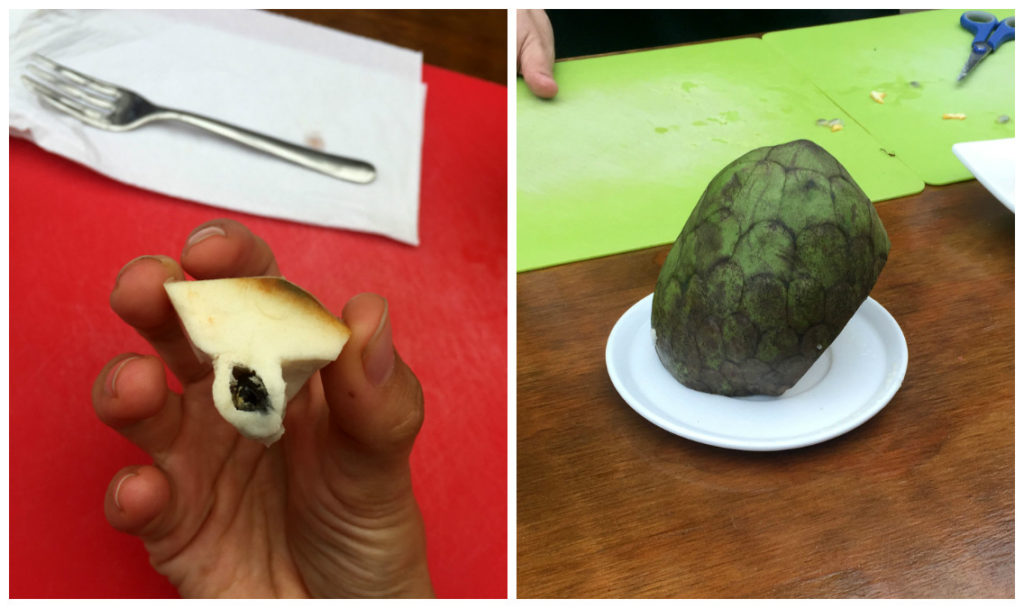
It looks armadillo-like because of the scale pattern on the skin. The peel is soft and easy to cut through and the flesh is like sugar! No wonder it’s been called the “fruit of the gods.” It’s texture reminds me of a guava, but instead of a ball of many tiny seeds that are easy to eat, the chirimoya has large black seeds the diameter of a dime or nickel (depending on the size of the fruit).
We bought on our own from a fruit stand and it weighed over half a kilo and cost about 10 soles. Definitely worth it of course, although it’s so sweet I don’t know that any one person should eat a whole of that size in one go.
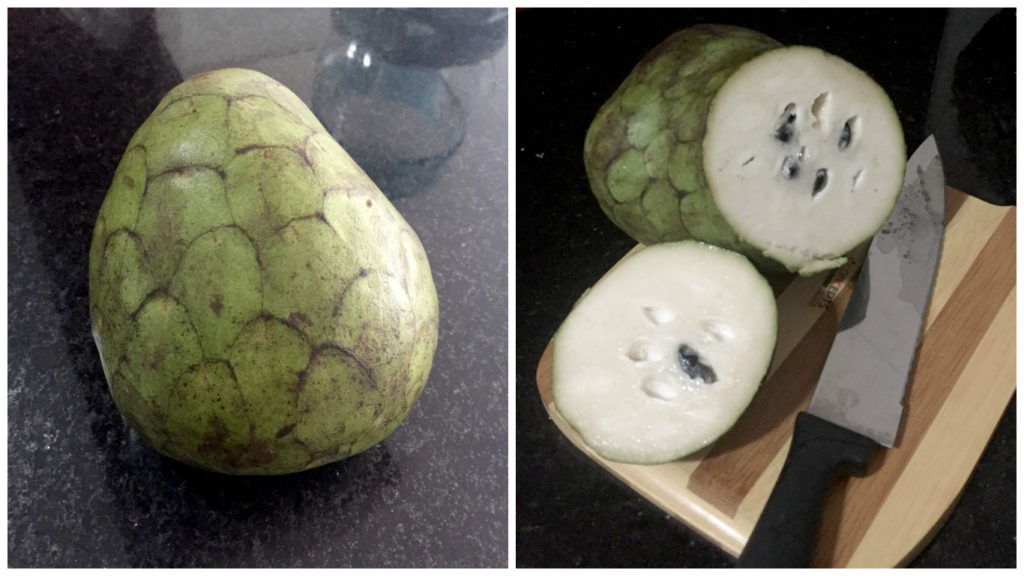
On the plus side of writing about a fruit tasting two weeks later, I’ve since tried a few other new fresh fruits.
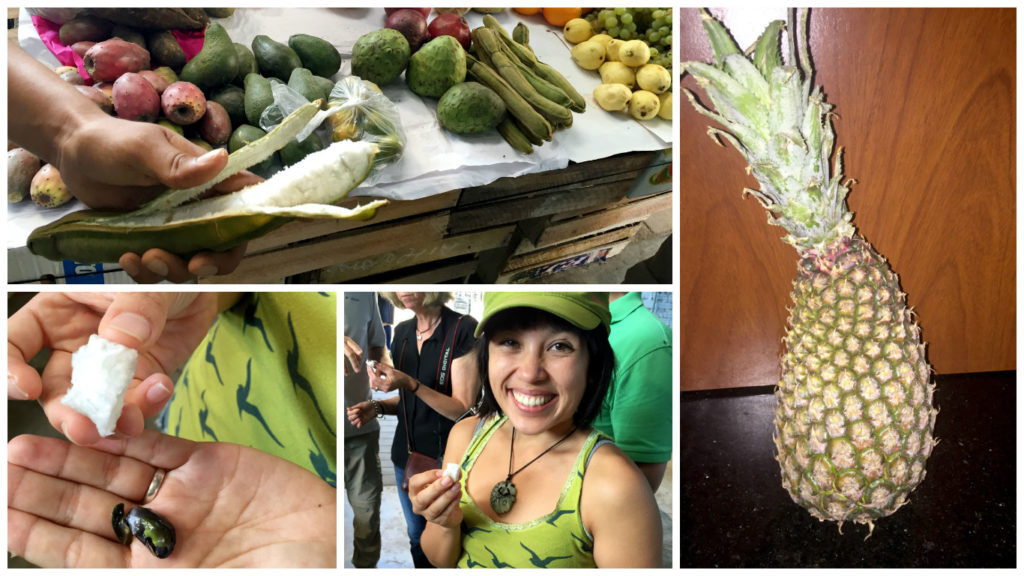
Pacae, or the “cotton candy bean” is a funky looking fruit. It comes in a long, velvety bean casing and when you peel it back, you see this cotton-looking flesh! It looked easy enough to peel, like a banana, and the fruit’s texture sorta reminded me of a banana too, though I wonder if that was because it reminded me of one visually. It’s very sweet and has bean-shaped seeds in it too (don’t eat those).
They also have Amazonian pineapples here, which have a pinkish tinge to their exterior and are much narrower on the top than the Hawaiian variety. The one we bought was ripe but wasn’t a very deep yellow color on the inside nor was it very sweet (ripeness tested via the pull-a-leaf-and-if-it-comes-off-easily-it’s-ripe test).
Last, but certainly not least, one of my favorite fruits of all time! The avocado. I’ve never seen this type of avocado before and at the market they were labeled “palta dedo,” or finger avocado. I’ve since also seen them listed as “palta sin pepas” because they’re seedless. They taste pretty much like what you’d expect from an avocado that has the same green/smooth skin, only without any seeds or pit at all!

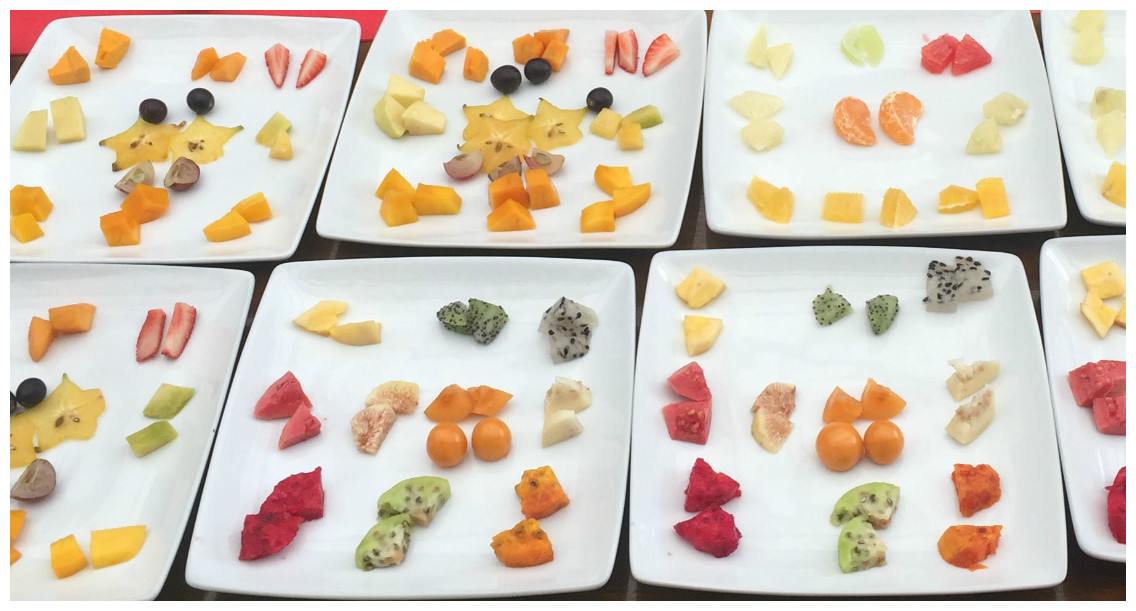
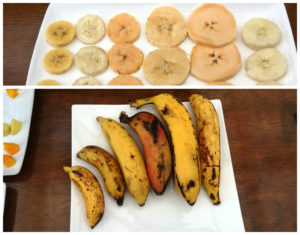

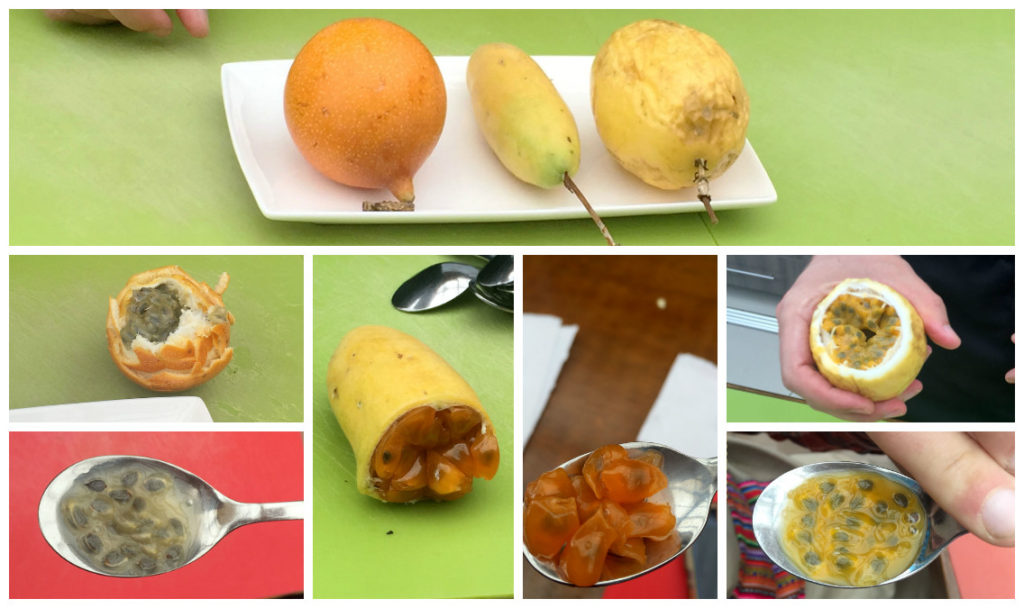
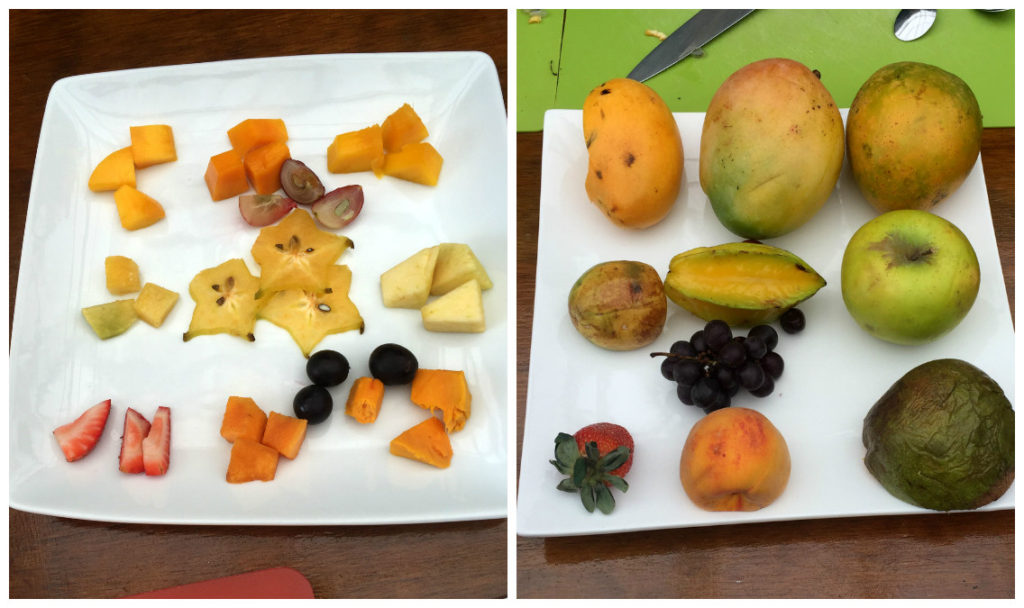
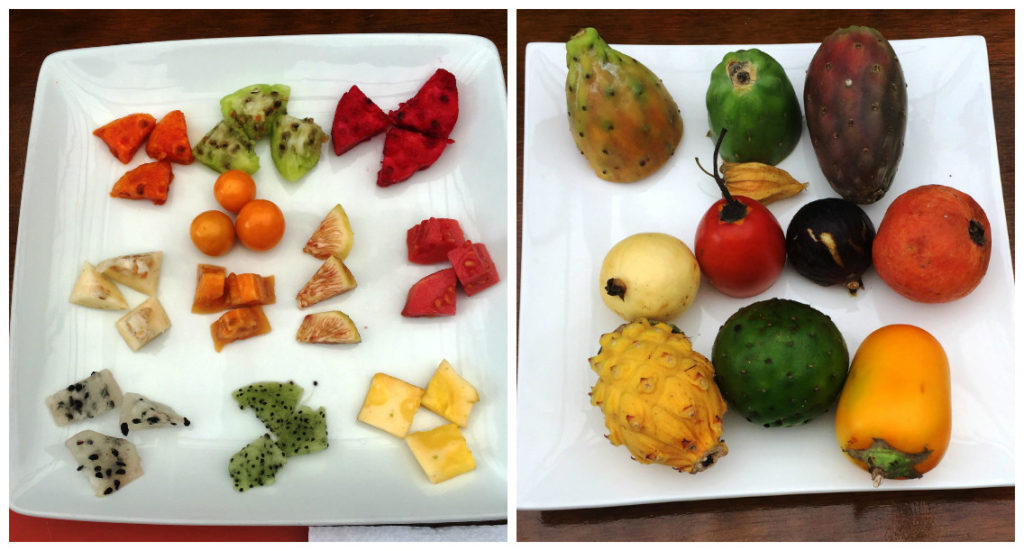
Pace looks like a fruit we call paterna the seed are cook and than eaten with lemon and salt
Sounds like you are discovering lots of new tastes and variation of fruits
Love it
Like pumpkin seeds! How cool, I wonder if it’s the same fruit.
What a tasting adventure! Like the idea of a seedless avocado!!